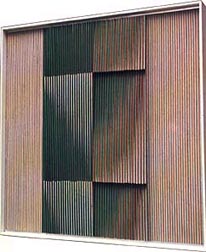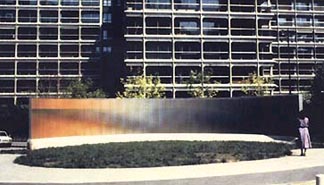After my blog on the value of location for public art, I was honored that Cruz-Diez sent me the following essay he wrote in 1996. If you don’t know his work, Cruz-Diez is one of the giants of 20th century art in Latin America. He was born in Caracas, Venzuela in 1922. In the 1960s, he began his physichromie series. These paintings, constructions and murals change color and patterns as the viewer moves. On his website, Cruz-Diez has animated the change of one artwork. If you are visiting south Florida, two works are on permanent display at the Boca Raton Museum of Art.
His essay below reminds us of the potential of power of art in our cities and its impact on the psyche of the citizen.

Physichromie No 370, 1967
“THE STREET AS SUPPORT OF ART EVENT”
Toward a poetic of the urban space
Carlos Cruz-Diez
1996
To consider art with regard to architecture and the street is to go through universal history from remote antiquity. It was not until late last century – almost at the advent of the industrial society and of profitability – that the artist was no longer called upon into great architectural projects. Since then the artist turned into easel painting and indoors sculpture.
Art, in many cases served the purpose of spreading out the image of power. It was a required tool of communication for empires and religions. Since most people were illiterate, mass media communication and information were achieved through paintings and sculptures in temples, Palaces and streets. Doctrines and dogmas, with few exceptions, were also promulgated through paintings and sculptures.
Speaking in contemporary terms, to commission an artist for portraying the image of a king was made initially in order to elaborate a “campaign of promotion and information”. But that “information ” was handled at such an artistic level and with such an efficiency that it was later brought into the field of the “aesthetic” and the sublime. Hence, the utilitarian works of yesterday are still arising our admiration today.
This brings me to believe that the “aesthetic” is nothing more than the result of perfecting a discourse and the evidence of its efficacy.
As kingdoms got to an end and religions managed to codify its communication with people, the utilitarian role of art diverted into what could be considered as “the pure state of art”: a fundamental and eternal mechanism of expression, discovery and spiritual communication among men.
It is within this conception that today we confront the artistic creation. In an intimate manner, as in paintings and sculptures of collections, or at an urban monumental level, since our streets and habitats are still valid supports of communication and expression in art.
Since the artist’s participation in current society neither meets the same connotations nor complies with the same utilitarian functions as in the past, I believe that his or her performances in public spaces may create unprecedented situations of sublimation, of breaking up conditioning, of spiritual assistance in disrupting gregarious codes and encouraging when bringing back our gone ability to marvel.
For thousands of years, human beings dwelled in dispersed fields and scattered villages. Their collective behavior and notion of freedom were very different from ours. We are learning about a new living situation because urban agglomeration is a relatively recent condition. Our vital space is becoming continually reduced. We must control our gestures and movements in order not to disturb our neighbors.
The only found solution allowing our survival and coexistence within this new way of living, has been constraint and codification which condition man to be submissive, to become more “standard,” thus reducing his chance to be different.
In view of this situation, the dweller of the great city has adopted the attitude of an automaton, of an indifferent creature; he does not think, he just acts. In his everyday wandering about, he crosses a pedestrian path or stops on a red light, embracing learned codes, lacking the awareness of the act. He fuses into the multitudes of the city, without having a recollection of his acts.
It is in this difficult scenario – which promises to worsen in the future – where artists might have a protagonist role. Not only to express their plastic discourses, but also to get involved in structuring the spiritual well being of the man of the megalopolis. In an imminent idle society, both art in particular and cultural activities in general will be of outmost importance for social peace.
I believe that the work of art conceived as urban spectacle, could achieve higher importance in today’s city than in the past. Through it, our dormant perception would be awaken, so what is neutral, codified, or automatic would be transformed into motivating “situations;” adding to the spiritual legacy of the robotized passer-by.
But a city should not be crowded with works of art. They would become banal objects and loose their fundamental purpose. Installing them on the streets should be the outcome of the reflection of a team integrated by the artist, the town planner, the architect, the engineer, the landscape architect, artisans, technicians, and promoters. Based upon the concepts outlined above, they should orchestrate the most adequate solutions for the location, scale and atmosphere of a given work.
Art on the street could “animate further readings,” leading toward different levels of information, knowledge and the pleasure to “see,” not to look.
On the other hand, the streets are also ideal supports of non-institutionalized ephemeral work. The artist can create in the passer-by, the impact of situations of fondness, surprise, amusement, and rupture by exciting his or her imagination.
In the past, one single person, “the artist,” conceived and accomplished everything. Our parceling up of knowledge has brought the artist’s action to be divided into diverse professions and specialties.
In a project, the artist should be convened as part of the creator team and not be called when everything has been decided, for “decorating” or mending a deficiently conceived solution of space.
I say this because, currently, the artist is never expected to be included in a team assigned to conceive environmental and urban projects. The artist’s irreverent condition in front of “dogmas,” could generate unprecedented solutions. He could inspire the imagination of a working team that many times becomes embedded in professional routines.
Urban environment could be deteriorated even further if the reflections exposed above are not taken into consideration. Works should not be installed without first considering the location, space, scale and type of work.
In my pursuit, I have tried to encounter non-traditional solutions to the perception of the chromatic world and plastic space. As a searcher, I have believed – since early age – that art is communication and that the artist should provide works, not only to purvey museums and collections, but also permeate into everything that touches the collectivity.
I think that a work of art integrated into the community or the habitat, should engender unprecedented events in constant mutation. This is a way to extend the “call for its reading in time” and to distinguish it from the utilitarian object of the street furniture.
The works I make for the urban environment and the habitat are conceived as plastic discourses generated in time and space, while creating “situations” and “chromatic events,” and modifying the dialectic between the spectator and the work. They are not “referential discourses,” as in the Gothic, the Renaissance or the Mexican muralists, but they profess a distinct start point in which real time and space substitute referred or transposed ones. They are, indeed, “the supports of an event” which changes end evolves, according to the path of light and to the spectator’s angle of view and distance.
They constitute “realities” and “autonomous” situations. “Realities,” inasmuch as they are events evolving from time and space, and “autonomous” situations, since they do not depend on the anecdotist discourse that the spectator expects to meet in art. A different learning relationship thus is established. Spectators discover their ability to create or to break down color by their own perceptive means. They discover the “making of the color,” emerging and dissolving before their eyes.

Physichromie Double Face, Paris, 1976, 18 meters by 3 meters
Public Art, Public Space
